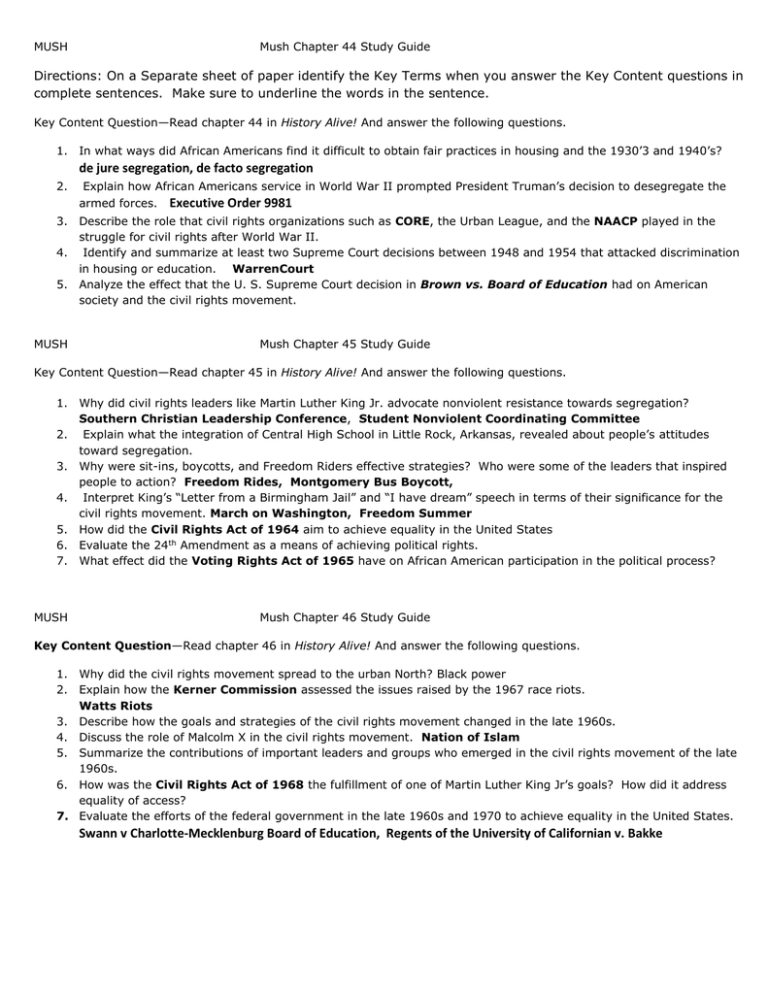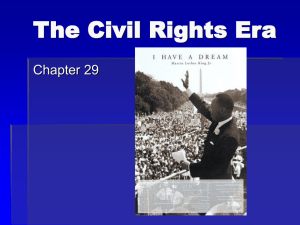MUSH Mush Chapter 44 Study Guide Directions: On a Separate
advertisement

MUSH Mush Chapter 44 Study Guide Directions: On a Separate sheet of paper identify the Key Terms when you answer the Key Content questions in complete sentences. Make sure to underline the words in the sentence. Key Content Question—Read chapter 44 in History Alive! And answer the following questions. 1. In what ways did African Americans find it difficult to obtain fair practices in housing and the 1930’3 and 1940’s? de jure segregation, de facto segregation 2. Explain how African Americans service in World War II prompted President Truman’s decision to desegregate the armed forces. Executive Order 9981 3. Describe the role that civil rights organizations such as CORE, the Urban League, and the NAACP played in the struggle for civil rights after World War II. 4. Identify and summarize at least two Supreme Court decisions between 1948 and 1954 that attacked discrimination in housing or education. WarrenCourt 5. Analyze the effect that the U. S. Supreme Court decision in Brown vs. Board of Education had on American society and the civil rights movement. MUSH Mush Chapter 45 Study Guide Key Content Question—Read chapter 45 in History Alive! And answer the following questions. 1. Why did civil rights leaders like Martin Luther King Jr. advocate nonviolent resistance towards segregation? Southern Christian Leadership Conference, Student Nonviolent Coordinating Committee 2. Explain what the integration of Central High School in Little Rock, Arkansas, revealed about people’s attitudes toward segregation. 3. Why were sit-ins, boycotts, and Freedom Riders effective strategies? Who were some of the leaders that inspired people to action? Freedom Rides, Montgomery Bus Boycott, 4. Interpret King’s “Letter from a Birmingham Jail” and “I have dream” speech in terms of their significance for the civil rights movement. March on Washington, Freedom Summer 5. How did the Civil Rights Act of 1964 aim to achieve equality in the United States 6. Evaluate the 24th Amendment as a means of achieving political rights. 7. What effect did the Voting Rights Act of 1965 have on African American participation in the political process? MUSH Mush Chapter 46 Study Guide Key Content Question—Read chapter 46 in History Alive! And answer the following questions. 1. Why did the civil rights movement spread to the urban North? Black power 2. Explain how the Kerner Commission assessed the issues raised by the 1967 race riots. Watts Riots 3. Describe how the goals and strategies of the civil rights movement changed in the late 1960s. 4. Discuss the role of Malcolm X in the civil rights movement. Nation of Islam 5. Summarize the contributions of important leaders and groups who emerged in the civil rights movement of the late 1960s. 6. How was the Civil Rights Act of 1968 the fulfillment of one of Martin Luther King Jr’s goals? How did it address equality of access? 7. Evaluate the efforts of the federal government in the late 1960s and 1970 to achieve equality in the United States. Swann v Charlotte-Mecklenburg Board of Education, Regents of the University of Californian v. Bakke MUSH Mush Chapter 47 Study Guide Complete each the assignment on a separate sheet of paper. Key Content Terms—Define and explain the significance of each key content term listed. Key Content Question—Read chapter 47 in History Alive! And answer the following questions. 1. Summarize the goals of the women’s rights movement of the 1960s and 70s. National Organization for Women (NOW) women’s liberation 1. Evaluate the effectiveness of the Equal Pay Act of 1963, the Civil Rights Act of 1964 and Title IX of the Education Amendments of 1972 in bringing equal opportunity and rights for women. 2. Describe the strategies of Cesar Chavez in the struggle for farm worker rights. How were his strategies similar to those advocated by Martin Luther King Jr.? United Farm Workers (UFW) 3. How did La Raza Unida express the rising consciousness of Mexican Americans? 4. What tactics did radical AIM activist use to try to alert Americans to the lack of equal rights opportunities for Indians? 5. What were some goals of Asian American activists of the 1960s and 70s and what tactics did they use? What were the results? Japanese American Citizens League (JACL) 6. What were other groups and how did they learn from the Africans American Civil Rights Movement? Americans with Disabilities Act (ADA), Stonewall riots, Gray Panthers





